The concept of Judgement is not confined to Christianity. For example, when an ancient Egyptian died he expected to journey through Duat, the kingdom of Osiris. He would undergo many tests and trials and hopefully arrive at the place of judgement where Anubis would weigh his heart against the feather of Maat, the goddess of truth and justice. If his heart was heavier or lighter than the feather his soul was thrown to Ammit, the Devourer of Souls, but if it was in balance with the feather his soul continued to paradise and eternal life.
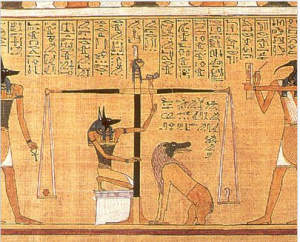
But the Judgement key is a depiction of the Christian Judgement Day. In his first letter to the Thessalonians, 5:16, the Apostle Paul describes Judgement Day: “For the Lord himself will descend from heaven with a cry of command, with the archangel’s call, and with the sound of the trumpet of God. And the dead in Christ will rise first; then we who are alive, who are left, shall be caught up together with them in the clouds to meet the Lord in the air…”
Most Judgement keys show an Angel calling the dead up out of their coffins with a mighty blast from a trumpet, just like Paul’s description. The horn is huge and lines of sound pour out from its bell. Jagged spikes lancing out from the angel underscore the power of the scene. Note that it is sound and not light that wakes the dead. Our sense of hearing is more primal than our sense of sight. It is easy to sleep through daybreak, but an alarm clock is impossible to ignore. We “see” objects all the time in our dreams, but when we “hear” a voice or sound in a dream it is such a powerful experience that it often wakes us up. Unlike an image, which we can easily decide was “only a dream”; we have trouble dismissing a sound as nothing.
But Paul doesn’t tell the Thessalonians which archangel will appear with the Lord and he isn’t clear about who is blowing the trumpet. The author of Revelations tells us that it will be the archangel who sounds the blast during the apocalypse: “…the seventh angel blew his trumpet, and there were loud voices in heaven…” Rev. 11:15. But he also neglects to tell us who that seventh angel is. And so there is disagreement amongst my sources over whether the trumpet player is Michael or Gabriel or Moroni.
Moroni?
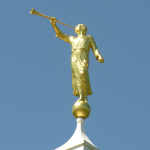
Mormons believe that Moroni was an ancient North American prophet who appeared to Joseph Smith as an angel and directed him to the golden plates from which the Book of Mormon was translated. Note the trumpet. But I strongly doubt that the angel in this tarot key is Moroni. The New World hadn’t even been discovered and, of course, the Church of the Latter-day Saints didn’t exist when tarot cards became popular in the 15th century.
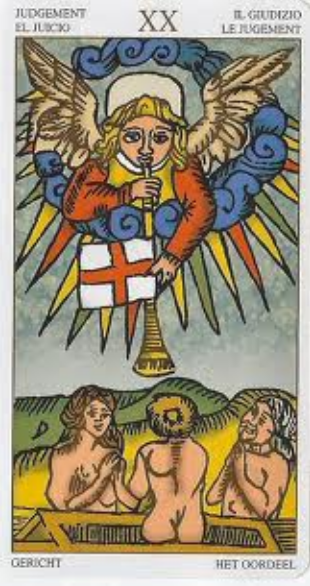
In his book, The Tarot, a Key to the Wisdom of the Ages, Paul Foster Case assures us that the angel “is obviously the angel Gabriel, not only because he carries a trumpet, but also because Gabriel is the angel of the element of water, which is indicated by his blue robe.” In the B.O.T.A. and Rider-Waite-Smith decks the angel’s robe is, indeed, blue, but his wings are red, the usual color for the element of fire, which is Michael’s element. In the Marseilles decks, the angel’s robes are a variety of colors, often red. Also, the angel Gabriel has only recently been pictured with a trumpet. In medieval art he is almost always pictured with lilies or other white flowers.
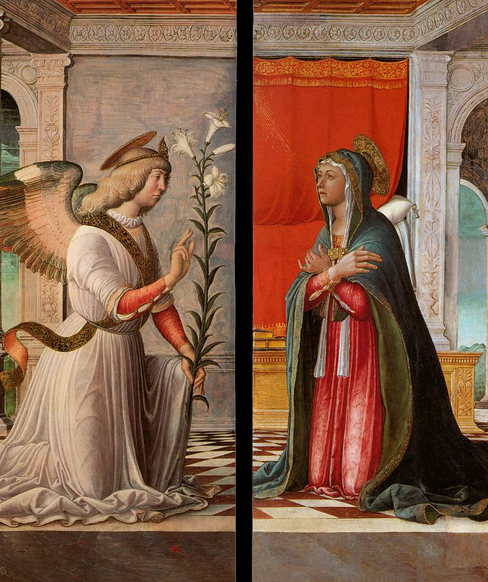
S. Vernon McCasland has found perhaps the earliest depiction of a trumpeting angel resurrecting the dead in an Armenian illuminated manuscript dated 1455, at the Walters Art Museum, Baltimore.* However, as far as I could tell, there was no mention that the angel is Gabriel.
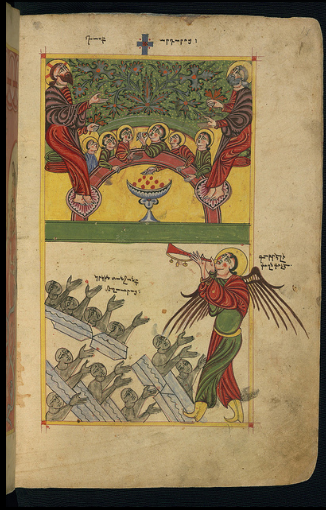
The first mention in English literature of Gabriel as trumpeter is in John Milton’s Paradise Lost (1667). * “Betwixt these rockie pillars Gabriel sat, Chief of the Angelic guards” (IV.545f)… he Blew his trumpet, heard in Oreb since perhaps When God descended, and perhaps once more To sound at general doom.” (IX.73ff). And although it isn’t mentioned in the Qur’an, the traditional Islamic trumpeter of doom is Israfil, not Gabriel.
In The Devil’s Picture Book, Paul Huson assures us that the angel “is undoubtedly Saint Michael, the archangel, and he can be recognized as such if not by the action he performs, then by his traditional cross-emblazoned banner floating from the trumpet itself.”
The Catholic church gives the Archangel Michael four responsibilities:
- “To fight against Satan.
- To rescue the souls of the faithful from the power of the enemy, especially at the hour of death.
- To be the champion of God’s people, the Jews in the Old Law, the Christians in the New Testament; therefore he was the patron of the Church, and of the orders of knights during the Middle Ages.
- To call away from earth and bring men’s souls to judgment (“signifer S. Michael repraesentet eas in lucam sanctam”, Offert. Miss Defunct. “Constituit eum principem super animas suscipiendas”, Antiph. off. Cf. The Shepherd of Hermas, Book III, Similitude 8, Chapter 3).” **
So, according to Catholic teaching, it is obviously Michael, not Gabriel who will preside over Judgement Day. But Huson was only half right. The white banner with the red cross is St George’s cross, not St Michael’s cross, which is a blue cross on a white background. However, a quick perusal of Google images for Archangel Michael revealed a few depictions of him carrying a white shield with a red cross, but none of him carrying a blue cross in any form.
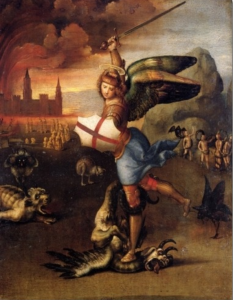
And I actually found a picture of him blowing a trumpet.
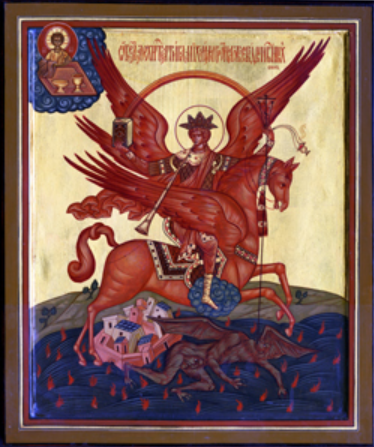
It is obviously Michael—not only because Holy Trinity Studios says so, but also because, as in many other depictions of him, he is killing satan.
But this is still only educated guess-work. Why not ask someone who has actually spoken with the archangels? According to Doreen Virtue’s post “8 ways to recognize Archangel Michael” this archangel has a loud, clear, matter of fact voice. She says it’s a voice you can’t ignore and actually pictures a trumpet shaped megaphone next to this description. His aura is a royal purple that’s so bright it looks like cobalt blue. And he’s hot. The people he visits often perspire and some women feel like they’re having hot flashes. Michael offers support, courage, and confidence.
Gabriel, however, “is the archangel of communication, often announces what’s on the horizon, and acts like a manager or agent in orchestrating new ventures related to one’s soul purpose.” *** He gives insights through dreams and meditation.
So which one of these two angels would be more likely to sound a trumpet till the dead rise from their graves and escort the quick and the dead through an apocalypse and into heaven?
Archangel Michael?
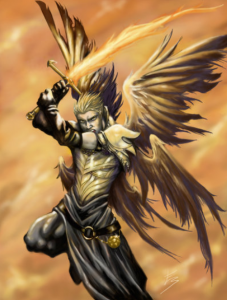
Or Archangel Gabriel?
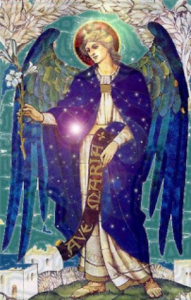
I’m betting that angel would be Michael. Anyone want to bet on Gabriel? We only have till Judgement Day to find out who wins.
*S Vernon McCasland, “Gabriel’s Trumpet” Journal of Bible and Religion 9.3 [August 1941:159–161].
**Catholic Encyclopedia: St Michael the Archangel.
***Doreen Virtue, Archangels 101: How to Connect Closely with Archangels Michael, Raphael, Uriel, Gabriel and Others for Healing, Protection, and Guidance,


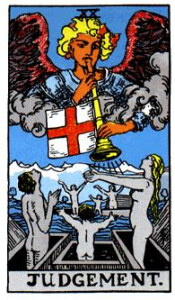
16 thoughts on “Judgement, Part I: Name that Angel”
Fascinating discussion, and well researched. I tend to say that neither angel is involved and prefer to call this card The Aeon and think of it in a Rise of the Phoenix into the new from the ashes of the old.
Malcolm
Not such a different outlook. Take away all the Christian trappings of this card and you get essentially that message. In fact, that’s sort of what the next blog’s about.
Malcom, Chrissy – I like that idea. I certainly feel much more comfortable with THAT concept as opposed to the Christian judgement tradition or the task of getting my heart as light as a feather like the ancient Egyptians! I look forward to the above-mentioned next post, and the book, of course.
Also, Trucking Yogi will be back from vacation this month, and (hopefully) in a new and improved, web friendly format.
Sorry it took me so long to get up to date with your last post!
I use the Motherpeace deck, and at a recent workshop combining Tarot and writing for insight, out of the several decks available to me, I used it again. The Judgement card in that deck pictures a violet ankh with a white light shining a rainbow down to enclose the planet earth.
In the movie “Constantine” the arch angel Gabriel is portrayed by Tilda Swindon, as a warrior and personal trainer to encourage resistance to the Devil. The movie does not end well for Gabriel, but the Devil loses as well. Both are injured by pride, while the “sinner” Constantine, is saved from his evil ways through humility and compassion for others.
“Gabriel come blow your horn,” is how the song goes.
I’m willing to wait a long time to see which angel wins the bet. In the meantime, I’ll continue to hedge mine, and bet “Win, place and show.”
I’m happy to wait a really long time. I like this world.
“Constantine” sounds like a good movie. Thanks for the recommendation.
We need to do lunch again. My house?
How like you to have given this so much thought. Love it, and LOVE all the beautiful illustrations.
Glad you enjoyed it.
I know it’s a nit picky detail that, in the grand scheme of things, will never make one diddley squat bit of difference to the world, but I just got sucked in and couldn’t stop researching it.
I did pick up a few gems of information along the way.
I *love* the research you did on this. Really gives the whole book (which I am looking forward to) some depth.
It does give more depth to my perception of Judgement, which is what the second to last chapter of Forging the Blade is about. I’m totally rewriting it.
Great picture, Ron. (He looks just like that in real life, everybody!)
Zadkiel (Zedkiel) also known as Tzadkiel, Satqiel, and Zachiel. (“Righteousness of God”) Zadkiel is the Chief of Dominations. Belonging to the ranks of the dominations, and considered by some to be chief, Zadkiel is considered an angel of mercy. It is he who holds back the hand of Abraham to prevent the patriarch from sacrificing his son, and because of this is usually shown holding a dagger. Also, Zadkiel is one of two standard bearers (along with Zophiel) who follow directly behind Michael as the head archangel enters battle.
So you’re saying Zadkiel is the angel on the Judgement key. I see nothing in your description of him that would suggest this. Is there a reference that mentions him as the angel of Judgement?
Ruler of the Order of the Seraphim ; Governer of February and one of the 7 Archangels.
Tell me more.
What is the archangel’s name?
Thank you! Glad you are enjoying it.